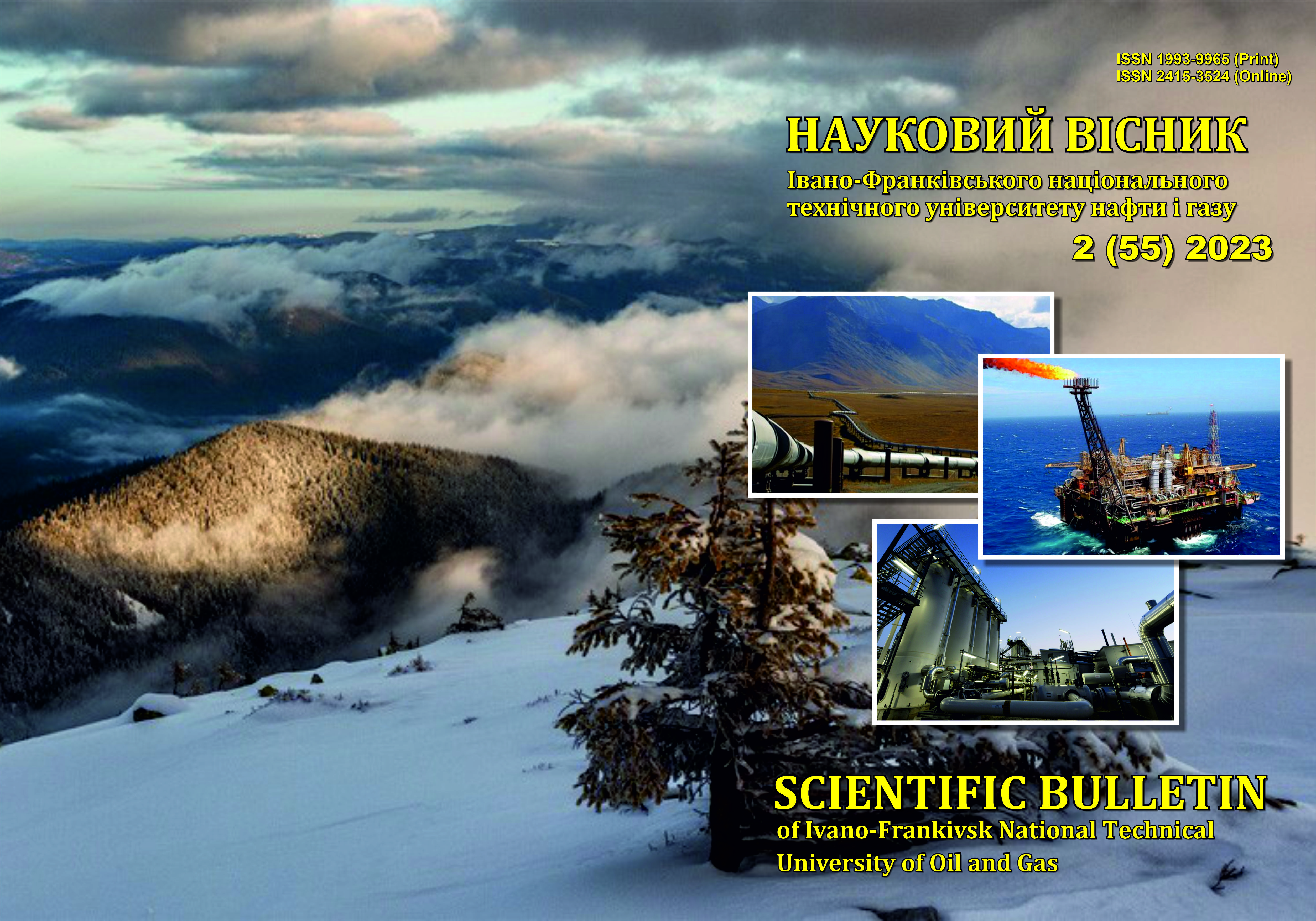Simulation of the components of the mixed flow of a well jet pump
DOI:
https://doi.org/10.31471/1993-9965-2023-2(55)-54-60Abstract
Based on the use of the mathematical apparatus of the theory of functions of a complex variable, a method of modeling the distribution of the working flow in the flow part of the jet pump for the conditions of its rotation in the well in the form of a combination of point leakage and vortex is proposed. The structure of the hydrodynamic function of the complex variable of the combined flow is established by the combination of partial solutions of the differential equations of motion of the elementary radial and circulation flows. The study of the obtained characteristic function made it possible to evaluate the influence of the displacement of the leakage and vortex centers on the characteristics of the ejection system and to take into account the misalignment and asymmetric placement of the elements of the flow part of the jet pump. Considering the analyticity of the function of the complex potential, we determine the speed of the combined flow by differentiating it. For a symmetric velocity field, the maximum value of its horizontal component corresponds to the axis of the mixing chamber of the jet pump. An increase in the size of the one-sided displacement of the vortex causes an increase in the rate of propagation of the radial circulation flow. The maximum value of the propagation speed of the asymmetric radial circulation flow corresponds to the one-sided simultaneous displacement of the leakage and the vortex in the flow part of the jet pump. The mutual configuration of the flow lines of the radial and circulation flow determines the character of the resulting hydrodynamic field of the combined flow.The streamlines of the two-dimensional and spatially symmetric radial flow are determined, respectively, by a series of straight lines passing through the center of coordinates and a set of meridional planes. For a vortex two-dimensional and three-dimensional symmetric flow, the streamlines are defined, respectively, by a series of concentric circles and spheres with the origin at the center of the outflow. Fluid flow is constant along the flow lines and planes and changes when moving to the adjacent hydrodynamic element. Taking into account the received configuration of flow lines and planes, particles of the liquid of the radial circulation flow move from the center of the leak to the periphery along smoothly changing spiral trajectories.
Downloads
References
Moon T. The Defining Series: Jet Pumps. Oilfield Review. Published: 11.02.2016. 2 p. https://www.slb.com/-/media/files/oilfield-review/ defining-jet-pumps.ashx.
Ayna T., Dilibal S. Experimental and nu- merical analysis for improving the suction capacity of the manufactured water jet ejectors. Journal of Vibroengineering. 2022, Vol. 24. Iss. 7. P. 1364 – 1376. https://doi.org/10.21595/jve.2022.22518.
Sheha A.A, Nasr M., Hosien M.A., Wahba E. Computational and Experimental Study on the Water-Jet Pump Performance. Journal of Applied Fluid Mechanics. 2018. Vol. 11. Iss. 4. P. 1013 - 1020. https://doi.org/10.29252/jafm.11.04.28407.
Merrill R., Shankar V., Chapma T. Three- Phase Numerical Solution for Jet Pumps Applied to a Large Oilfield. Proceeding of Abu Dhabi International Petroleum Exhibition & Conference, Abu Dhabi, UAE, November 9–12 2020. Paper Number: SPE-202928-MS. 9 p. https://doi.org/ 10.2118/202928-MS.
Zhu H.-Y., Deng J.-G., Zhao J.-Y. Vortex methods reducing the bottom-hole differential pressure. Journal of Mines, Metals and Fuels. 2012. Vol. 60. Iss. 5. P. 81–90.
Yang Y., Wu S., Wang C., Jiao W., Ji L., An C., Ge J. Effect of effuser throat diameter on the internal flow structure and energy characteristics of the jet pump. Energy Reports. 2023. Vol. 9. P. 2075–2086. https://doi.org/10.1016/ j.egyr.2023.01.025.
Zhu H. Y., Liu Q.Y. Pressure drawdown mechanism and design principle of jet pump bit. Scientia Iranica B. 2015. Vol. 22. Iss. 3. P. 792– 803.
Chen X., Cao T., Yu K., Gao D., Yang J., Wei H. Numerical and experimental investigation on the depressurization capacity of a new type of depressure-dominated jet mill bit. Petroleum Science. 2020. Vol. 17. P. 1602–1615. https://doi.org/10.1007/s12182-020-00472-8.
Zhu H.-Y., Liu Q.-Y., Wang T. Reducing the bottom-hole differential pressure by vortex and hydraulic jet methods. Journal of Vibroengineering. 2012. Vol. 16. Iss. 5. P. 2224–2249.
Panevnyk D.A. Simulation of a downhole jet-vortex pump’s working process. Nafta-Gaz. 2021. No. 9. P. 579–586. https://doi.org/10.18668/ NG.2021.09.02.
Panevnyk D.O. Vykorystannia kompleksnoho potentsialu ploskoradialnoho potoku dlia modeliuvannia robochoho protsesu sverdlovynnoho strumynnoho nasosa. Naukovyi visnyk IFNTUNH. 2022. No 1(52). P. 42–49. https://doi.org/10.31471/ 1993-9965-2022-1(52)-42-49. [in Ukrainian]
Panevnyk D.O. Vykorystannia vykhrovoi funktsii dlia modeliuvannia robochoho protsesu sverdlovynnoho strumynnoho nasosa. Rozvidka ta rozrobka naftovykh i hazovykh rodovyshch. 2022. No 3(84). P. 24–32. https://doi.org/10.31471/1993- 9973-2022-3(84)-24-32. [in Ukrainian]
Downloads
Published
How to Cite
Issue
Section
License
Авторські права....


1.png)

















